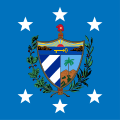Raúl Castro
Raúl Modesto Castro Ruz (American Spanish: [raˈul moˈðesto ˈkastɾo ˈrus]; born 3 June 1931) is a Cuban politician who is currently serving as the First Secretary of the Communist Party of Cuba, the most senior position in the communist state,[6] succeeding his brother Fidel Castro in April 2011. He has also been a member of the Politburo of the Communist Party of Cuba, the highest decision-making body, since 1975. In February 2008, he was appointed the President of the Council of State and President of the Council of Ministers. He stepped down as President on 19 April 2018, but remains the first secretary of the Communist Party, still holding considerable influence over government policy.[7]
Raúl Castro | |
|---|---|
.jpg) | |
| First Secretary of the Communist Party of Cuba | |
| Assumed office 19 April 2011 | |
| President | Himself Miguel Díaz-Canel |
| Prime Minister | Manuel Marrero (since 2019) |
| Deputy | José Ramón Machado |
| Preceded by | Fidel Castro |
| President of the Council of State and Ministers of Cuba | |
| In office 24 February 2008 – 19 April 2018 | |
| Vice President | José Ramón Machado Miguel Díaz-Canel |
| Preceded by | Fidel Castro |
| Succeeded by | Miguel Díaz-Canel |
| Second Secretary of the Communist Party of Cuba | |
| In office 3 October 1965 – 19 April 2011 | |
| First secretary | Fidel Castro |
| Preceded by | Position established |
| Succeeded by | José Ramón Machado |
| 1st First Vice President of Cuba | |
| In office 2 December 1976 – 24 February 2008 | |
| President | Fidel Castro |
| Preceded by | Position established |
| Succeeded by | José Ramón Machado |
| Minister of Defence | |
| In office 16 February 1959 – 24 February 2008 | |
| Prime Minister | Fidel Castro |
| Preceded by | Position established |
| Succeeded by | Julio Casas Regueiro |
| Secretary-General of the Non-Aligned Movement | |
| In office 24 February 2008 – 16 July 2009 Acting: 31 July 2006 – 24 February 2008 | |
| Preceded by | Fidel Castro |
| Succeeded by | Hosni Mubarak |
| President pro tempore of CELAC | |
| In office January 28, 2013 – January 28, 2014 | |
| Preceded by | Sebastián Piñera |
| Succeeded by | Laura Chinchilla |
| Personal details | |
| Born | Raúl Modesto Castro Ruz 3 June 1931 Birán, Cuba |
| Political party | Popular Socialist Party (Before 1953) 26th of July Movement (1953–1965) Communist Party (1965–present) |
| Spouse(s) | |
| Children | 4, including Mariela and Alejandro |
| Relatives | Fidel Castro (brother) Ramón Castro Ruz (brother) Juanita Castro (sister) |
| Signature | |
| Military service | |
| Allegiance | |
| Branch/service | Revolutionary Armed Forces |
| Years of service | 1953–59 |
| Rank | |
| Unit | 26th of July Movement |
| Battles/wars | Cuban Revolution Cuban Missile Crisis |
| Awards | Hero of the Republic of Cuba[1] Order of Prince Yaroslav the Wise[2] National Order of Mali[3] Order of the Quetzal[4] Order Prince Daniel of Good Faith First Degree[5] |
Prior to being appointed acting President of Cuba in July 2006, he served as the commander-in-chief of the Armed Forces from 1959 to 2008. His ministerial tenure made him the longest serving minister of the armed forces. Because of his predecessor's illness, Castro was designated the President of the Council of State in a temporary transfer of power. Castro was officially made President by the National Assembly on 24 February 2008, after Fidel Castro, who was still ailing, announced on 19 February 2008 that he would not stand for President again.
Castro was re-elected President on 24 February 2013. Shortly thereafter, Castro announced that his second term would be his final term, and that he would not seek re-election in 2018.[8] He stepped down as Cuban president on 19 April 2018 after his successor was elected by the National Assembly following parliamentary elections. He remained as First Secretary of the Communist Party,[6] Cuba's ruling party,[9][10] is head of the constitutional reform commission,[11] and also continues to have a seat representing Santiago de Cuba's Segundo Frente municipality in the National Assembly.[12]
He is expected to step down as First Secretary at the Eighth Congress of the Communist Party of Cuba, which is scheduled to take place 16 to 19 April 2021.[13][14]
Early life
Raúl Modesto Castro Ruz was born in Birán, Cuba, the son of a Spanish immigrant father, Ángel Castro who was 55 at the time of his birth, and a Cuban-born mother of Canarian parentage, Lina Ruz. Raúl is the youngest of three brothers: Ramón, Fidel, and himself.[15] He also has four sisters: Angela, Juanita, Emma, and Agustina. Ángel Castro's first wife, Maria Argota, also raised five half-siblings of Raúl: Pedro Emilio, Maria Lidia, Manuel, Antonia, and Georgina.
As children, the Castro brothers were expelled from the first school they attended. Like Fidel, Raúl later attended the Jesuit School of Colegio Dolores in Santiago and Belen Jesuit Preparatory School (Spanish: Colegio Belén) in Havana. Raúl as an undergraduate studied social sciences. Whereas Fidel excelled as a student, Raúl turned in mostly mediocre performances.[16] Raúl became a committed socialist and joined the Socialist Youth, an affiliate of the Soviet-oriented Cuban Communist Party, Partido Socialista Popular (PSP).[17][18] The brothers participated actively in sometimes violent student actions.[19]
Raúl Castro's travels and contact with Soviet KGB agent Nikolai Leonov — whom he met in 1953 during a trip to the Soviet-bloc nations and again in 1955 during his exile in Mexico City — facilitated Cuba's close ties with the Soviets after the triumph of the Cuban Revolution. Leonov would later become the USSR's KGB agent in Havana.[17]
In 1953, Raúl served as a member of the 26th of July Movement group that attacked the Moncada Barracks; he spent 22 months in prison as a result of this action.[20][21] During his exile in Mexico, he participated in the preparations for the expedition of the boat Granma to Cuba.
Commander in the Cuban Revolution

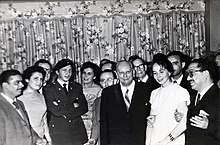

When the Granma landing failed and the 82 expeditionaries were detected by government troops soon after, Raúl was one of only 12 fighters who managed to reach a safe haven in the Sierra Maestra mountains, forming the core of the nascent rebel army (see the Cuban Revolution). As Fidel's brother and trusted right-hand man, and given his proven leadership abilities during and after the Moncada attack, he was given progressively bigger commands. On 27 February 1958 Raúl was made comandante and assigned the mission to cross the old province of Oriente leading a column of guerrillas to open, to the northeast of that territory, the "Frank País Eastern Front".
As a result of Raúl's "Eastern Front" operations, he was not involved in the pivotal Operation Verano (which came close to destroying the main body of fighters but ended up a spectacular victory for Fidel), but Raúl's forces remained active and grew over time.
On 26 June 1958, Raúl Castro's rebels kidnapped ten Americans and two Canadians from the property of Moa Bay Mining Company (an American company) on the north coast of Oriente Province. The next day rebels took hostage 24 US servicemen on leave from the United States naval base at Guantanamo Bay. This incident brought total kidnapped hostages to 36 (34 US and 2 Canadian citizens).
US Ambassador Smith and his staff determined the kidnappings had the following objectives: Obtain worldwide publicity, regain M-26-7 prestige lost by general strike call failure, force Batista's Air Force to stop bombing rebel holds, and gain public recognition from the US. Two tactical objectives the kidnapping achieved for Castro forces can be discerned from contemporaneous reporting in Time: Batista declaring a ceasefire for negotiations, forcing a reduction in Operation Verano air raids; the rebels used the lulls to regroup and fly in arms.
The hostage-taking caused significant US backlash, including unfavorable public reaction, and US consideration to re-establishing military support to Batista and deploying US forces to free the hostages. Ultimately, the hostages were released in very small groups, extracting the maximum press attention.[22] After their release, the hostages said they were treated well with some even claiming to support the rebel cause.[23]
Regarding the captured Batista government soldiers, Raúl Castro notes in his war diaries: "All three were brought food and told that they would be released and only their weapons would be kept. They had money and watches we needed, but according to our principles, we didn't touch them. In the territories under guerrilla control, it created an autonomous structure by establishing hospitals, schools and several material manufacturing plants. In 1958, he was also at the origin of the M-26 intelligence services.[24]
By October 1958, after reinforcement by Fidel, the brothers had about 2,000 fighters and were operating freely throughout Oriente province. In December, while Che Guevara and Camilo Cienfuegos were operating in Santa Clara, Fidel and Raúl's army laid siege to Maffo, capturing it on 30 December. Their victorious army then headed to Santiago de Cuba, capital of Oriente province.
In response to the victory by Che Guevara at the Battle of Santa Clara, the U.S.-backed President Fulgencio Batista fled Cuba in the early morning of 1 January 1959.[25] The two Castro brothers with their army arrived on the outskirts of Santiago de Cuba and said their forces would storm the city at 6 P.M. on 1 January if it did not first surrender. The commander (Colonel Rego Rubido) surrendered Santiago de Cuba without a fight. The war was over and Fidel was able to take power in Havana when he arrived on 8 January 1959.
Raúl's abilities as a military leader during the revolution are hard to see clearly. Unlike Che Guevara or Cienfuegos, Raúl had no significant victories he could claim credit for on his own. The last operations (which were clearly successful) were conducted with his older brother Fidel present (and in command).[26] After Batista's fall, Raúl had the task of overseeing trials and execution of between 30 and 70 soldiers loyal to deposed president Batista who had been convicted of war crimes.[27]
Political career
Early political career
Raúl Castro Ruz was a member of the national leadership of the Integrated Revolutionary PO Organizations (established July 1961; dissolved March 1962) and of the United Party of the Socialist Revolution of Cuba (established March 1962; dissolved October 1965). He is also credited with helping shoot down a Lockheed U2 and killing Major Rudolf Anderson.[28]
He served as a member of the Central Committee of the Communist Party of Cuba and Second Secretary of its Politburo from the Party's formation in October 1965; also as First Vice President of the Cuban Council of State of the National Assembly of People's Power and Council of Ministers when these were established in 1976. He was appointed Minister of the Revolutionary Armed Forces when it was founded in October 1959 and served in that capacity until February 2008.
Assumption of presidential duties
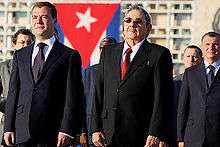
On 31 July 2006, Fidel Castro's personal secretary, Carlos Valenciaga, announced on state-run television that Fidel Castro would provisionally hand over the duties of First Secretary of the Communist Party of Cuba (party chief), President of the Council of State of Cuba (head of state), President of the Council of Ministers of Cuba (prime minister), and Commander-in-Chief of the Armed Forces to Raúl Castro while Fidel underwent and recovered from intestinal surgery to repair gastrointestinal bleeding.[29][30]
Many commentators regarded Raúl Castro as a political hardliner who would maintain the Communist Party of Cuba's influence in the country. However, others believed that he was more pragmatic than his older brother and willing to institute some market-oriented economic policies. It was speculated that he favored a variant of the current Chinese and Vietnamese political and economic model for Cuba in the hopes of preserving some elements of the socialist system.[27]
Raúl is considered by some to be less charismatic than his brother Fidel Castro, who remained largely out of public view during the transfer-of-duty period.[31] His few public appearances included hosting a gathering of leaders of the Non-Aligned nations in September 2006, and leading the national commemoration of the 50th anniversary of the landing of the boat Granma, which also became Fidel's belated 80th-birthday celebrations.[32][33]
In a speech to university students, Raúl stated that a communist system in Cuba would remain, and that "Fidel is irreplaceable, unless we all replace him together."[34]
On 1 May 2007 Raúl presided over the May Day celebrations in Havana. According to Granma the crowd reached over one million participants, with delegations from over 225 organizations and 52 countries.[35]
Raúl has a reputation for his businesslike, unanimated delivery of speeches.[36]
Communist leader


After assuming what was envisioned as a temporary control over the presidency in 2006, on 24 February 2008 Raúl Castro won election as the new President of the Council of State and President of the Council of Ministers during a legislative session held at Cuba's Palace of Conventions in Havana. The 597 deputies unanimously elected a 31-member Council of State for a term of five years, which in turn elected Raúl as president.[37] His administration subsequently announced several economic reforms. In March 2008 the government removed restrictions on the purchase of numerous products not available under Fidel Castro's administration - including DVD-players, computers, rice cookers, and microwaves.[38] In an effort to boost food production, the government allowed private farmers and cooperatives to lease idle state-owned land and moved much of the decision-making process regarding land use from the national level to the municipal level.[39]
All death sentences (about 30) are commuted between 2008 and 2010, although none had been executed since 2003.[40]
In mid-2008, the government overhauled the salary structure of all state-run companies so that harder-working employees could earn higher wages.[41] In addition, the government removed restrictions against the use of cell phones and investigated the removal of travel restrictions on Cubans.[38]
In March 2009, Raúl Castro dismissed some officials.
In April 2011, Raúl announced a plan of 300 economic reforms encouraging private initiative, reducing state spending, encouraging foreign investment and agrarian reforms. He also announced a limitation on presidential terms, including his own.
On 24 February 2013, Cuba's parliament named Raúl Castro to a new five-year term as president and appointed Miguel Díaz-Canel as his first vice president. Castro announced that day that he would step down from power after his second term as president ended in 2018.[42]
In 2018, he was selected as a candidate for the National Assembly of People's Power by the Segundo Frente municipality in Santiago de Cuba, regarded as the cradle of the Cuban Revolution.[43]
Miguel Díaz-Canel took over as President of Cuba (President of the Council of State) on 19 April 2018. Raúl Castro remains First Secretary of the Central Committee of the Communist Party (in office since 19 April 2011).
Normalization of relations with the United States
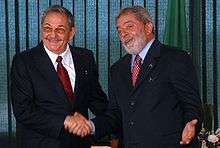
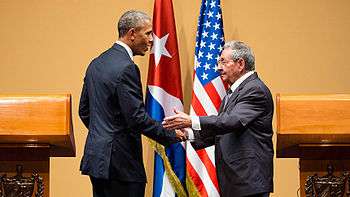
Raúl Castro said in a 2008 interview: "The American people are among our closest neighbors. We should respect each other. We have never held anything against the American people. Good relations would be mutually advantageous. Perhaps we cannot solve all of our problems, but we can solve a good many of them."[44]
On 10 December 2013, Castro, in a significant move, shook hands with and greeted American President Barack Obama at the Nelson Mandela memorial service in Johannesburg.[45]
On 17 December 2014, Castro and Obama made separate announcements that efforts to normalize relations between the two nations would begin with the re-establishment of embassies in Havana and Washington. The embassies had previously been dissolved in 1961 after Cuba became closely allied with the USSR.[46][47]
The rapprochement between the U.S. and Cuba was facilitated by Argentine-born Pope Francis, who allowed the Vatican to be used for secret negotiations. There were simultaneous public announcements by Castro and Obama about the progress toward normalization.[48]
On 20 July 2015, Cuba and the United States officially resumed full diplomatic relations with sections of "Cuban interests" in Washington, D.C., and "U.S. interests" in Havana upgraded to embassies.[49]
On 20 March 2016, Obama made a visit to Cuba to meet with Castro. It was the first visit of a sitting U.S. president to Cuba in 88 years.[50]
Speaking in 2017, Raúl Castro was highly critical of Donald Trump's proposition of the Mexican wall and restrictive trade policy. He called his plans egotistical and for the border, irrational. "You can't contain poverty, catastrophes, and migrants with walls, but with cooperation, understanding, and peace," Castro said.[51] The U.S. President-elect also targeted Raúl in a tweet, saying, "If Cuba is unwilling to make a better deal for the Cuban people, the Cuban/American people and the U.S. as a whole, I will terminate deal".[52]
Raúl Castro surprised a top American envoy in September 2017 while discussing recent sonic attacks on American diplomatic staff. He denied involvement but allowed FBI rare access to investigate the incident that has left 21 people with hearing loss and brain damage.[53]
Public and personal life
Castro married Vilma Espín, a former Massachusetts Institute of Technology chemical engineering student and the daughter of a wealthy lawyer for the Bacardi rum company, on 26 January 1959.[54] Vilma became president of the Cuban Federation of Women.[55] They have three daughters (Déborah, Mariela, and Nilsa) and one son (Alejandro) Castro Espín.[56]
Their daughter Mariela Castro currently heads the Cuban National Center for Sex Education, while Déborah is married to Colonel Luis Alberto Rodríguez, head of the Armed Forces' economic division.[57] Vilma Espín died on 18 June 2007; a daughter and some relatives of Raúl are believed to reside in Italy.
In an interview in 2006, following his assumption of presidential duties, Raúl Castro commented on his public profile stating: "I am not used to making frequent appearances in public, except at times when it is required ... I have always been discreet, that is my way, and in passing I will clarify that I am thinking of continuing in that way".[58]
In an interview with actor Sean Penn, Raúl Castro was described as "warm, open, energetic, and sharp of wit".[44]
After a meeting with Pope Francis in Vatican City on 10 May 2015, Castro said that he would conditionally consider returning to the Roman Catholic Church.[59] He said in a televised news conference, "I read all the speeches of the pope, his commentaries, and if the pope continues this way, I will go back to praying and go back to the [Roman Catholic] church. I am not joking."[48] The pope visited Cuba before his September 2015 visit to the United States. Castro said: "I promise to go to all his Masses and with satisfaction," when Pope Francis visited Cuba in 2015.[60] Castro considered Christ a communist stating, "I think that's why they killed Jesus, for being a communist, for doing what Fidel defined as revolution... changing the situation."[61]
US sanctions
In September 2019, Castro was sanctioned and barred from entering the United States due to support of the Nicolás Maduro government in Venezuela during the presidential crisis, and the human rights abuses perpetuated by the regime.[62]
In popular culture
In the 1969 American film Che!, Castro was played by Paul Bertoya. In the 2002 film Fidel, he was played by Maurice Comte. In the 2008 American biographical film Che, he was played by Rodrigo Santoro.
Honours and awards
- Hero of the Republic of Cuba
- Jubilee Medal "In Commemoration of the 100th Anniversary since the Birth of Vladimir Il'ich Lenin" (USSR, 1970)
- Order of the October Revolution (Soviet Union, 2 June 1981)
- Order of the Holy Prince Daniel of Moscow, 1st class (Russian Orthodox Church, 19 October 2008) – For the contribution to strengthening inter-religious cooperation in connection with the consecration of the church of Our Lady of Kazan in Havana
- Order of Prince Yaroslav the Wise, 1st class (Ukraine, 26 March 2010)
- Order of Lenin (USSR)
- Grand Collar of the Order of the Liberator (Venezuela)
- Medal of Friendship (People's Republic of China, 29 September, 2019)
References
Citations
- Castro, Fidel (2007). Fidel Castro Reader. Ocean Press. pp. 37. ISBN 9781920888886.
- "Kiev Ukraine News Blog". Kiev Ukraine. Retrieved 12 January 2013.
- "Orders, Decorations and Medals – Medals of Cuba". Jean Paul Leblanc. Retrieved 12 January 2013.
- Antonio de la Cova. "Cuba Foreign Relations". Latin American Studies. Retrieved 12 January 2013.
- "Orders, Decorations and Medals, Medals of Cuba". Jean Paul Leblanc. Retrieved 12 January 2013.
- "Raul Castro to lead Cuba's Communist Party until 2021". France 24. 19 April 2018.
'I confirm to this assembly that Raul Castro, as first secretary of the Communist Party, will lead the decisions about the future of the country,' Diaz-Canel said.
- "Raul Castro leaving Cuban presidency, not power". Associated Press. 18 April 2018.
Raul Castro's official title will remain first secretary of the Communist Party, heading the elite 17-member Political Bureau and the broader Central Committee.
- Peter Orsi (24 February 2013). "Cuba's Raul Castro announces retirement in 5 years". Yahoo! News. Retrieved 6 April 2013.
- "Raul Castro Confirms He Will Stay Cuba's President to April 2017". Washington Post. Retrieved 4 March 2019.
- "Fidel Castro announces retirement". BBC News. 18 February 2008. Retrieved 24 February 2008.
- "Cuba ditches aim of building communism from draft constitution". The Guardian. 22 July 2018. Retrieved 22 July 2018.
- "Raúl votes in the Santiago municipality of Segundo Frente". En.granma.cu. Retrieved 4 March 2019.
- http://en.granma.cu/cuba/2019-12-20/led-by-raul-the-11th-plenum-of-the-communist-party-central-committee-held
- https://www.cnn.com/2018/04/19/americas/cuba-new-president-named/index.html
- "Raúl Castro Ruz". Britanica. Retrieved 10 November 2008.
- José de Córdoba, David Luhnow and Bob Davis (2 August 2006). "Castro's Illness Opens Window on Cuba Transition". The Wall Street Journal. pp. 1, 12.
- Miguel A. Faria Jr. (15 August 2001). "Who is Raúl Castro? (Part I)". News Max. Retrieved 5 August 2006.
- Faria, Miguel. "Who Is Raul Castro? (Part II)". Retrieved 22 August 2001.
- "Revolutionary Firing Squads". 2008. Retrieved 20 February 2008.
- Rojas, Marta (4 September 2006). "When Raúl Castro assumed responsibility for the assault on the Moncada Garrison". Archived from the original on 21 August 2006.
- Faria, Miguel. "Fidel Castro and the 26th of July Movement". Retrieved 27 July 2004.
- "CUBA: Caught in a War". Time. 14 July 1958.
- Pierre Kalfon, Che, 1997
- "50 verdades sobre Raúl Castro". Operamundi.uol.com.br. Retrieved 8 June 2019.
- Audio: Cuba Marks 50 Years Since 'Triumphant Revolution' by Jason Beaubien, NPR All Things Considered, 1 January 2009
- John Pike. "The Spirit Of Moncada: Fidel Castro's Rise To Power, 1953 – 1959". Globalsecurity.org. Retrieved 6 April 2013.
- Tim Padgett and Dolly Mascarenas (2 August 2006). "Why Raul Castro Could End Up a Reformer". Time. Retrieved 5 August 2006.
- "Castro Urged Soviet Nuclear Attack in '62". Los Angeles Times. Reuters. 23 November 1990.
- Phillip Hart (30 July 2006). "From Castro to Castro". London: Daily Telegraph. Retrieved 5 August 2006.
- "Fidel Castro Says Health Stable in Statement Read on State Television". FoxNews.com. 1 August 2006. Archived from the original on 13 August 2006. Retrieved 5 August 2006.
- "Castro recovering and giving orders: Chavez". Reuters. 3 September 2006. Archived from the original on 25 October 2006.
- Weekend Edition Saturday (2 December 2006). "Cuba Marks Belated Birthday for Ailing Castro". NPR. Retrieved 6 April 2013.
- "Raul Castro greets Chávez on Fidel's 80th birthday". 2008. Retrieved 20 February 2008.
- "Raul Castro 'not imitating Fidel'". BBC News. 21 December 2006. Retrieved 20 February 2008.
- "Millions of Cubans demand imprisonment for terrorist Posada Carriles". 2008. Archived from the original on 5 March 2008. Retrieved 20 February 2008.
- "Raul offers Cuba a quieter Castro voice — CNN.com". 2008. Archived from the original on 29 February 2008. Retrieved 20 February 2008.
- "Raul Castro elected president of Cuba_English_Xinhua". News.xinhuanet.com. 25 February 2008. Archived from the original on 6 November 2012. Retrieved 12 January 2013.
Cuban army general Raul Castro was elected the new president of Cuba on Sunday during a legislative session held at Cuba's Palace of Conventions in Havana.
- Neill, Morgan (26 April 2008). "Raul Castro pushes change for Cubans". CNN. Retrieved 26 April 2008.
- Marc Frank, "Raúl Castro Overhauls Cuba's Farm Bureaucracy", Reuters News, 1 May 2008.
- "Cuba: dernière peine de mort commuée". Lefigaro.fr. 29 December 2010. Retrieved 8 June 2019.
- Frances Robles, "Cubans Who Work More Will Get Higher Salaries", Miami Herald, 12 June 2008.
- "Cuba names Raul Castro to new term as president". Fox News. Retrieved 24 February 2013.
- "Raul Castro Nominated For Cuba's Parliament". Miami.cbslocal.com. 23 January 2018. Retrieved 4 March 2019.
- "Conversations With Chávez and Castro". The Nation. 25 November 2008. Retrieved 12 January 2013.
- "Nelson Mandela's memorial service". The Daily Mail. 10 December 2013. Retrieved 11 December 2013.
- Keane, Angela Greiling; Dorning, Mike (17 December 2014). "Obama Acts to End More Than Half-Century U.S.-Cuba Estrangement". Bloomberg News.
- Baker, Peter (18 December 2014). "Obama Announces U.S. and Cuba Will Resume Relations". The New York Times. Retrieved 18 December 2014.
- Yardley, Jim (11 May 2015). "Praising Pope, Cuban President says he might return to Church". The New York Times. p. A4.
- "U.S., Cuba restore full diplomatic ties after 5 decades". CBC News. 20 July 2015. Retrieved 20 July 2015.
- Korte, Gregory (March 21, 2016) "Obama meets Cuban President Raúl Castro", USA Today. Retrieved March 21, 2016.
- "Cuba's Raul Castro blasts Trump's Mexican wall and trade policy". Reuters.com. 6 March 2017. Retrieved 4 March 2019.
- Trump, Donald J. (28 November 2016). "If Cuba is unwilling to make a better deal for the Cuban people, the Cuban/American people and the U.S. as a whole, I will terminate deal". Twitter. Retrieved 4 March 2019.
- Gillies | AP, Josh Lederman, Michael Weissenstein and Rob (16 September 2017). "Raul Castro's surprising response to harmed US diplomats". Washington Post. ISSN 0190-8286. Archived from the original on 17 September 2017. Retrieved 17 September 2017.
- "Raul Castro Visited New Housing Project in Santiago de Cuba" Cuban News Agency via Cuban Radio Archived 27 November 2013 at the Wayback Machine. Retrieved 11 February 2009 from mathaba.net.
- "TIME magazine Milestones". Time Magazine. 9 February 1959. Retrieved 14 November 2006.
- "Raúl Castro". Miami Herald. 1 August 2006. Retrieved 5 August 2006.
- "Trying to make the sums add up". The Economist. 11 November 2010.
- "The Fidel Castro mystery". Sentinel & Enterprise. 2008. Retrieved 20 February 2008.
- MacLaughlin, Eliott C. (14 May 2015). "Raul Castro may join Catholic Church, he says after Pope Francis meeting". CNN.
- Anderson, Jon Lee (22 September 2015). "POPE FRANCIS IN CUBA". The New Yorker.
- https://www.irishtimes.com/news/christ-was-a-communist-says-castro-1.292935
- https://reuters.com/article/us-usa-cuba-castro/u-s-issues-travel-ban-for-cubas-castro-over-human-rights-accusations-support-for-venezuelas-maduro-idUSKBN1WB2B5
Sources
- Castro, Juanita; as told to María Antonieta Collins (2009). Fidel y Raul – Mis Hermanos, La Historia Secreta. Santillana USA Publishing Company, Inc. ISBN 978-1-60396-701-3.
External links
| Wikiquote has quotations related to: Raúl Castro |
| Wikimedia Commons has media related to Raúl Castro. |
- Raul Castro Stamps His Mark, Havana Times, 4 March 2009
- Who is Raul Castro, Cuba's new leader?, Times Online, 19 February 2008.
- Biography by CIDOB Foundation (in Spanish)
- Speech by Raúl Castro on July 26, 2007 (English translation), Escambray Digital, 27 July 2007.
- "Cuba in transition" in Starbroek News, 19 April 2007
- "Regime readies path for Raúl Castro's rise" by Frances Robles, Miami Herald, 14 July 2006.
- Raul Castro Books
- BBC Profile: Raul Castro, 24 February 2008
- Time Magazine: Castro Family Values: Fidel vs. Raul 17 April 2008
- Photographs of Raul Castro, 1964 – Duke University Libraries Digital Collections
- Appearances on C-SPAN
| Political offices | ||
|---|---|---|
| New office | Minister of Defence 1959–2008 |
Succeeded by Julio Casas Regueiro |
| First Vice President of Cuba 1976–2008 |
Succeeded by José Ramón Machado Ventura | |
| Preceded by Fidel Castro |
President of Cuba Acting: 2006–2008 2008–2018 |
Succeeded by Miguel Díaz-Canel |
| Party political offices | ||
| New office | Second Secretary of the Communist Party 1965–2011 |
Succeeded by José Ramón Machado Ventura |
| Preceded by Fidel Castro |
First Secretary of the Communist Party Acting: 2006–2011 2011–present |
Incumbent |
| Military offices | ||
| Preceded by Fidel Castro |
Commander-in-Chief of the Cuban Revolutionary Armed Forces Acting: 2006–2008 2006–present |
Incumbent |
| Diplomatic posts | ||
| Preceded by Fidel Castro |
Secretary-General of the Non-Aligned Movement 2006–2009 |
Succeeded by Hosni Mubarak |

